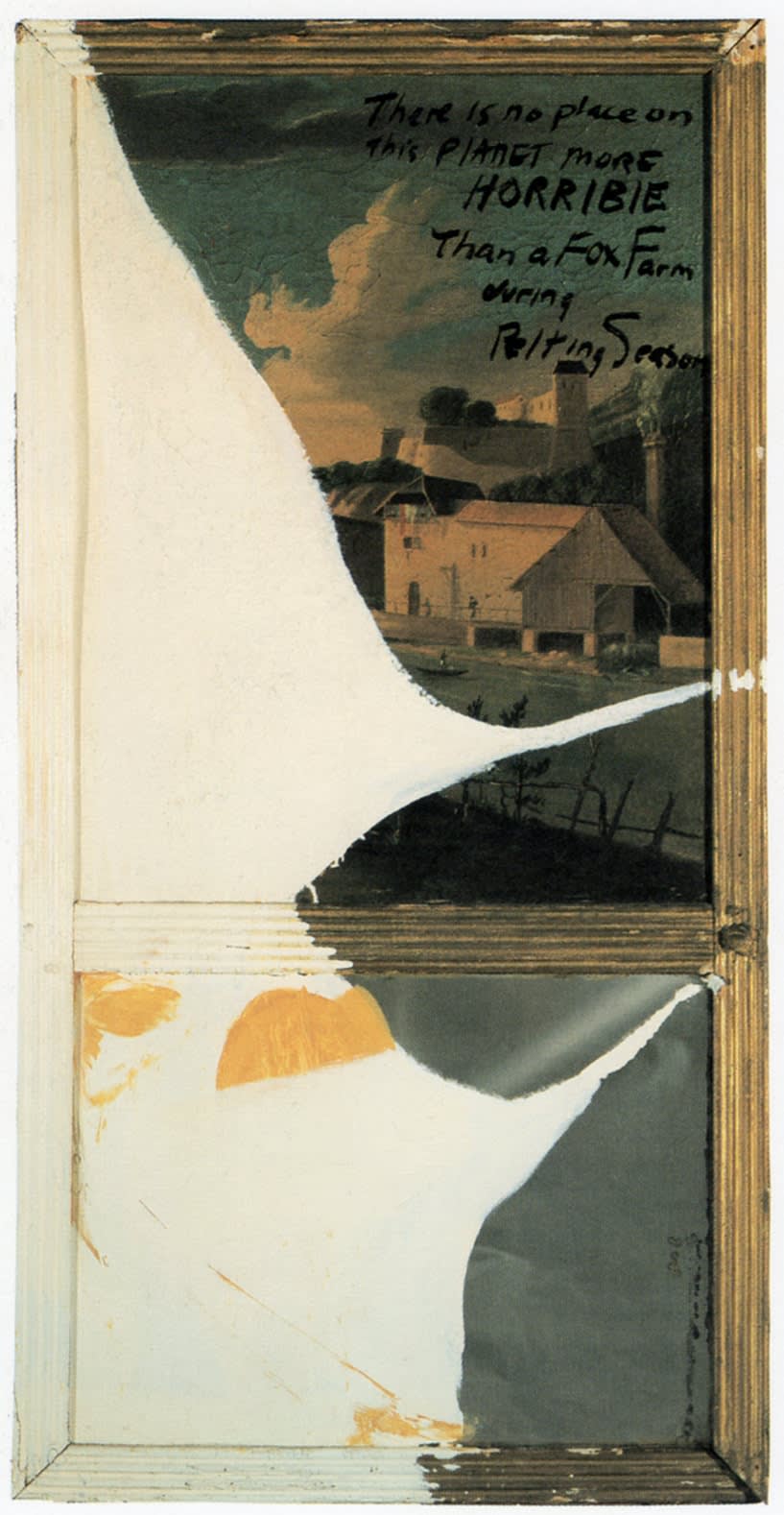Julian Schnabel
There Is No Place on This Planet More Horrible Than a Fox Farm During Pelting Season, 1989
Gesso and marker on found object (Wood and Mirror)
140 x 72 cm
Copyright The Artist
Julian Schnabel’s early series of works, collectively entitled “Fox Farm Paintings,” 1989, places him within the now broad spectrum of artists engaging/exploiting ecological themes and motifs as either entertainment or...
Julian Schnabel’s early series of works, collectively entitled “Fox Farm Paintings,” 1989, places him within the now broad spectrum of artists engaging/exploiting ecological themes and motifs as either entertainment or enlightenment. Repeated throughout these paintings is a phrase Schnabel discovered scrawled on a ten-dollar bill: “There is no place on this planet more horrible than a fox farm during pelting season.” Despite the phrase’s appeal to animal-rights enthusiasts, its tone of unmodulated asseveration makes its effect primarily histrionic. Probably there are several places on this planet more horrible than a fox farm during pelting season. The phrase is like an obscuring veil which must be rent so that the reader of these works may reach within them and discover their fictional reality.
It isn’t the evident, univocal meaning of the phrase that matters in Schnabel’s new paintings; rather, it is the rhetorical effect, one that inheres in the stylistic/emotive tendency with which the artist has always been associated—Expressionism.
A key member of the Neo-Expressionist movement that emerged in 1980s New York, Julian Schnabel makes monumental paintings that embrace material experimentation and feature thick drips, splatters, and expressive faces. Throughout his practice, which veers between figuration and abstraction, the artist has integrated textiles, broken plates, and snippets of text into his canvases.
The nature/culture dichotomy in Schnabel’s art ostensibly posits nature as the perpetual victim of culture’s depredations. Schnabel’s animal nature functions primarily as a displacement of human psychic torment.
While primarily known as a painter, Schnabel has also worked in sculpture and film. Common themes include sexuality, obsession, suffering, redemption, and death; privileging a grand, poetic scale, the work—and its creator—can seem larger than life. Schnabel received his BFA from the University of Houston before joining the Whitney Museum of American Art’s Independent Study Program for young artists. He has since exhibited in New York, London, Paris, Los Angeles, Berlin, Tokyo, Milan, and Hong Kong. His work has sold for seven figures at auction and belongs in the collections of the Metropolitan Museum of Art, the Museum of Modern Art, the Guggenheim Museum, the Museo Reina Sofía, the Centre Pompidou, and the Museum of Contemporary Art, Los Angeles.
It isn’t the evident, univocal meaning of the phrase that matters in Schnabel’s new paintings; rather, it is the rhetorical effect, one that inheres in the stylistic/emotive tendency with which the artist has always been associated—Expressionism.
A key member of the Neo-Expressionist movement that emerged in 1980s New York, Julian Schnabel makes monumental paintings that embrace material experimentation and feature thick drips, splatters, and expressive faces. Throughout his practice, which veers between figuration and abstraction, the artist has integrated textiles, broken plates, and snippets of text into his canvases.
The nature/culture dichotomy in Schnabel’s art ostensibly posits nature as the perpetual victim of culture’s depredations. Schnabel’s animal nature functions primarily as a displacement of human psychic torment.
While primarily known as a painter, Schnabel has also worked in sculpture and film. Common themes include sexuality, obsession, suffering, redemption, and death; privileging a grand, poetic scale, the work—and its creator—can seem larger than life. Schnabel received his BFA from the University of Houston before joining the Whitney Museum of American Art’s Independent Study Program for young artists. He has since exhibited in New York, London, Paris, Los Angeles, Berlin, Tokyo, Milan, and Hong Kong. His work has sold for seven figures at auction and belongs in the collections of the Metropolitan Museum of Art, the Museum of Modern Art, the Guggenheim Museum, the Museo Reina Sofía, the Centre Pompidou, and the Museum of Contemporary Art, Los Angeles.
